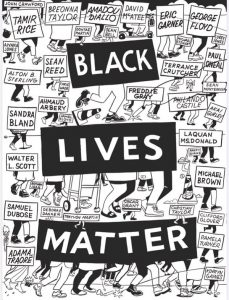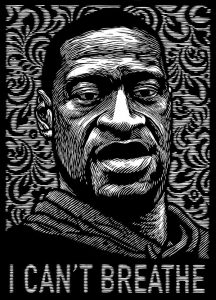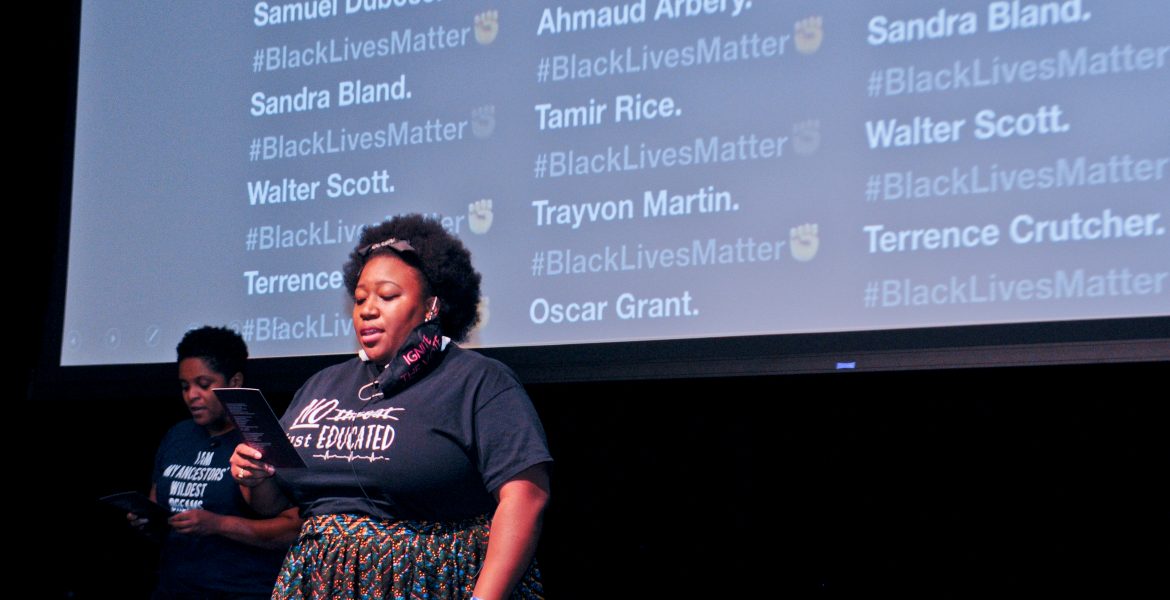On an overwhelmingly Hispanic campus, Black students are using their voices by speaking out against police brutality and systemic racism, calling for opportunities for involvement and making their presence known.
A poem memorializing the tragic events of summer 2020 will hang in the new Academic and Administration building at Texas A&M University-San Antonio; the poem will be joined by two artistic posters used during the San Antonio George Floyd protests.
After seeing members of her community die at the hands of police, former Student Government Association President La-Tieka Sims, penned her poem “Black Summer”. It expresses her anger and frustration after the deaths of George Floyd and other Black Americans made headlines across the nation.
“I got tired of hearing so many names in such a short time,” said Sims, who led the SGA during the 2019/2020 school year. “It’s always been a thing, but maybe because of COVID, maybe because there weren’t any distractions that you could use to get away from it, it just felt like so many names were being announced in the news, back to back to back. It’s like, when is it going to stop? When do we catch a break from this? It’s exhausting.”
The poem shares the perspective of a young Black person trying to enjoy themselves during the summer while victims of police brutality were pronounced dead on national news; it also lists the names of Breonna Taylor, George Floyd and Ahmaud Arbery – three Black people killed over the summer as a result of racially motivated violence and police brutality.

“You know the goal is always to / Turn up / Be in my bag / And kick it with somebody’s son,” the poem reads. “Ohhh oh hold up baby / come talk to me / don’t run / No but for real don’t run, or they’ll chase you down with guns like you stole something / And broadcast it to prove that they were justified / RIP Ahmaud Arbery.”
Sims, an international business senior, performed her poem during A&M-San Antonio’s virtual Juneteenth Solidarity Rally hosted as a collaboration between the SGA, the Black Student Union, The Coalition and the Mexican American Student Association.
Marissa Galvin, Black Student Union vice-president, said hearing the poem read aloud was impactful in many ways.
“I had seen (the poem), but there’s something about the written word being spoken and so, to hear her say it and with everything going on at the moment, it was a really powerful scene,” Galvin said.
Providing a permanent place for the poem
After the rally, university President Cynthia Teniente-Matson asked Sims to perform again during the fall 2020 faculty and staff convocation; she was joined by Galvin and Jamie Jackson, Zeta Phi Beta sorority campus president, during the recitation. After the performance, Matson said she was moved to make a permanent and visible sign of commitment and support from the university by hanging the poem on a plaque in the new building early next year.
“I felt that the building, because we opened it at the end of the summer in August and it was coming up when all those issues were happening in our community,” Matson said, “it’s a good way to memorialize, as long as that building is standing, what that summer was like.”
Kathryn Funk-Baxter, vice president for business affairs, said the plaque and posters will be a part of the Jaguar Reflections Wall, a project being overseen by the university’s new Campus Art, Grounds and Aesthetics committee. The wall will likely be displayed by January 2021.
Mari Fuentes-Martin, vice president of Student Success and Engagement, was involved in overseeing the Virtual Solidarity Rally as SGA adviser. She believes memorializing the poem will aid in the university’s mission of inclusion and equity.
“We want to create settings that are inclusive of all people,” Fuentes Martin said. “Latino students, when they come on campus, they see themselves in the art we have on campus, but do our Black students feel that way? … having that poem, the sentiments felt from our own students and our former student government president there permanently is a very powerful statement that we hear you and embrace your thoughts and emotions; we want that to be a permanent part of our campus.”
A call for more support
A&M-San Antonio’s fall 2020 student body is 75% Hispanic, 14% white and 6% Black, according to Jeanette De Diemar, vice-president of university advancement. The remaining 5% consists of Native American, Multiracial, Native Hawaiian or Pacific Islander, Non-Resident or Foreign Nationals and some unknown, according to Christopher Belcher, senior communication specialist. Sims said these demographics can make it difficult for Black students to be motivated to get involved on campus.
“Don’t get me wrong, TAMUSA is excellent about being inclusive and inviting, but when you are at a Hispanic-serving institution where most of the faculty and staff look like the majority of the students they serve, which is understandable, there’s not a lot of spaces for students that look like me,” Sims said.
Sims said knowing her poem will have a permanent spot on campus is comforting, but hopes it will spark more actionable changes on campus. Sims said she would like to see more campus events geared toward engaging Black students.
“With Latino culture, they have … the things that appeal to them, whether it’s the mariachis, the food, some of the traditions that you normally see associated with LatinX culture and you see that throughout the year; you don’t see that throughout the year for Black students,” Sims said.

Galvin echoed Sims, encouraging continuous support and engagement in the fight against systemic racism and social injustice.
“For me, the advocacy comes in the consistent doing of things; it doesn’t just stop at a plaque, it also continues with conversations, with engagement, with reaching out to students of color,” Galvin said. “(The plaque) is a great way to honor one of our students, but it shouldn’t stop there. My concerns will be what happens after this.”
Galvin and Sims suggested the university adopt the following steps toward solidarity and change:
- Having discussions and educational events surrounding microaggressions, a term used to describe subtle or indirect discriminatory actions or statements
- Not shying away from making public statements against systemic racism
- Having the demographics of the university administration reflect the students they serve
- Providing spaces and events where Black students feel celebrated and included
To stay involved in campus happenings, visit BSU’s JagSync page: https://jagsync.tamusa.edu/organization/black-student-union.
Black Summer
By La-Tieka Sims
You know the goal is always to
Turn up
Be in my bag
And kick it with somebody’s son
Ohhh oh hold up baby
come talk to me
don’t run
No but for real don’t run,
or they’ll chase you down with guns like you stole something
And broadcast it to prove that they were justified
RIP Ahmaud Arbery
But you know it’s been hot girl summer
Ain’t no Netflix and chill
We tryna get out and stay gone
And we don’t wanna kick it at home
It’s not like we’ll be safer there anyway
Like if we stay in our house
We can avoid the possibility of
our hot summer ending in hot bullets
Because we were in the wrong place at the wrong time
in our…own…damn…home
RIP Breonna Taylor
The summer is still young though and
I’m tryna make sure these fits is on point
So when I pull up to the spot
They won’t be ready for how my foot
gonna be on they necks
But I won’t keep the pressure on ‘em
I wanna make sure they can catch their breath
I can’t let myself be on my knees while they can’t breathe
And hear their last words be…
Ugh everything hurts! My stomach hurts, my neck hurts, I need water or something
please officer
I …can’t …breathe!
RIP George Floyd
I’m just tryna enjoy being black this summer
I’m tryna come through every kickback
And get turnt at every turnup
I’m tryna vibe wit my girls
And capture every golden hour
cause we don’t know when it will be my last hour
Because THEY thought I committed a crime or
THEY had the wrong address or
THEY just…wouldn’t …listen
And then THEY will have you saying RIP
to me
Veronica Valdes contributed to this story.







